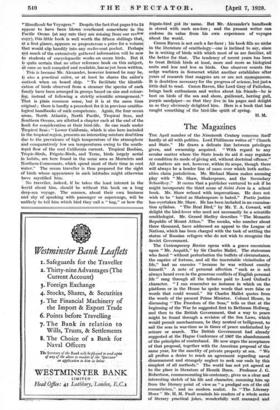Sea Birds
Tan older type of sailor was almost invariably a great lover of birds, if only in the sense that he liked catching albatrosses on a hook and line and making fancy waistcoats out of their feathers. (We have seen one of these garments, by the way ; it was a*■ exceedingly fine piece of work, and must have looked really dashing when worn with a sou'wester.) The present- day sailor, fortunately, has little time for catching albatrosses— steamships go too fast ; but he is still a lover of birds, and will lose no opportunity of bringing parrots and canaries on board, or of killing migratory warblers, owls, and swallows that have sought the sanctuary of the ship in mid-ocean. Happily, too, his superstitions about albatrosses and petrels still remain with him for the most part. There are days and days at sea when the great ocean fliers are in constant atten- dance on the ship, feeding royally on the contents of refuse buckets tipped over the stern. But, for all his knowledge and observation, the sailor is rarely a writer. There have been no ocean-wandering Gilbert Whites, none to jot down daily observations of the Man o' War Hawk's aerial manoeuvres in the ship's wake ; and consequently we do not yet know nearly so much as we should like to know about any of these magni- ficent creatures. While there are a dozen pairs of eyes ready to probe into the secrets of every English cuckoo's nefarious life, how many ornithologists are there who could tell you the colour of the Bo'sun Bird's egg, or even in what type of ground she lays it ?
Mr. Alexander very charmingly enlightens us in his little
"Handbook for Voyagers." Despite the fact that pages 9 to 24 appear to haVe been- blciwif "overboard someWhere in the !seine OCean (at any rate they are missing from- our review copy), this little book is well worth the fifteen shillings that,- at'a first glance, appears so preposterous a price for a volume that would slip handily into any reefer-coat pocket. PerhapS not much of the extensively gathered information will be new to students of encyclopaedic works on ocean birds. But it is quite certain that no other reference book on this subject, at once so well compiled and readable, has as-yet been written.
This is because Mr: Alexander, howeVer learned he may be, is also a practical sailor, or at least he shares the sailor's outlook when on board ship. " To facilitate the identifi- Cation of birds observed from a steamer the species of each family have been arranged in groups based on size and colour- ing, instead of following a strictly scientific arrangement." That is plain common sense, but it is at the same time original ; there is hardly a precedent for it in previous ornitho- lOgical handbooks of such competence. Ag7aiii; the four ocean areas, North Atlantic,- North PacifiC, Tropical Seas, and Southern Oceans, are allotted a chapter each at the end of the book for consideration of their bird-life. So one reads under Tropical Seni: " LOWer California, which is also here included in the tropical region, presents an interesting mixture doubtless due to the prevalence of high temperature of the atmosphere and comparatively low sea temperatures owing to the south- *iird flow of the cool California current. Tropical Boobies, tropic-Birds, Frigate-Birds, and Terns, birds largely aerial in habits, are here found in the same area as Murrelets and NOrthern Cormorants, which spend most of their time in cool water." The ocean traveller is thus prepared for the sight Of birds whose appearance in such latitudes • might otherwise have mystified him.- '
= No traveller, indeed, if he takes the least interest in the world about him, should 'be without this book on a long deep-sea voyage. The seamen, about their own business and shy of speaking with passenger or supeitargo, will be unlikely to tell him which bird they call a " hag," or how the frigate-bird got its name. But Mr. Alexander's handbook is stored with such sea-lore ; and the present writer can endorse its value from his own experience of voyages about the world.
Canon Raven is not such a far-farer ; his book fills no niche in the literature of ornithology—one is inclined to say, since he is writing of birds with which most of us are familiar, all the better for that. The tendency of recent years has been to treat British birds at least, more and more as biological units and less and less as birds. One observer counts the sedge warblers in Somerset whilst another establishes after years of research that magpies are :or are not monogamous. It is doubtless necessary for the progress of science, but just a
little dull to read. Canon Raven, like Lord Grey of Fallodon, brings back enthusiasm and writes about his friends—he is best on birds of the sea and shore, guillemot,. herring gull, purple sandpiper—so that they live in his pages and delight us as they obviously delighted him. Here is a book that has caught something of the bird-like spirit,of spring.
H. M.







































 Previous page
Previous page